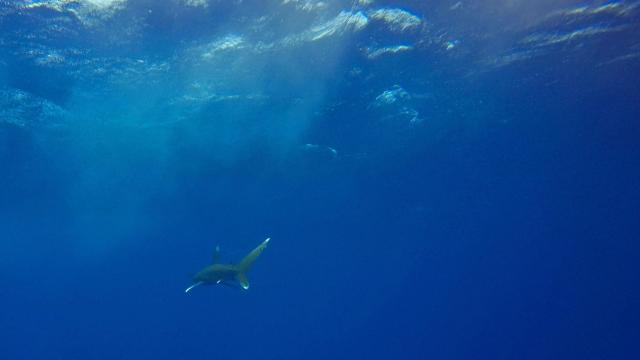Calling all dermatologists. There are some hot sharks who need you. Marine biologists say that warming oceans could be responsible for a mystery skin affliction that is taking a toll on sharks off the coast of Malaysia.
Divers first started seeing weird skin lesions on whitetip reef sharks in the waters off Sipadan Island, a world-renowned scuba spot in Malaysia, last year, according to local media. But after photos taken of one of the sad sharks went viral in April, a team of researchers started working to capture some of the afflicted sharks and figure out what’s going wrong.
The sharks’ skin condition, divers said, appears to have gotten more severe over the course of the past year. The photos are pretty gnarly: The sharks are sporting open lesions and white spots on the tops of their heads.
Datuk Mohamed Shariff Mohamed Din, a veterinary professor with a specialty in fish pathology at the Academy of Sciences Malaysia, told the Malay Mail in April that it looks like the sharks are stricken with fusariosis, a type of fungal infection that attacks weakened immune systems. It can be brought on by changes in the water, including temperature changes and pH shifts.
“In the wild, nothing much can be done to overcome the problem,” Mohamed Din said. “It is a natural phenomenon. If climate change triggered the disease due to temperature changes, then the weaker animals will succumb to the disease, and the healthy ones will survive. In the deeper oceans, the temperature changes may not be as severe. We will only know if there are reports of similar cases.”
The team that set out to crack the case in May spent five days trying to capture a shark but were unsuccessful. The scientists said that actually getting their hands on an afflicted shark and doing a scientific study is crucial to figuring out what’s going on. (The team said they’re planning to try again this month.)
But there are lots of clues that increasingly point to hotter oceans being at fault. Scientists noted that the average sea surface temperature in Spidan was 29.5 degrees Celsius last month, a full 1 degree Celsius higher than the average temperature in 1985. What’s more, sightings of the sickly sharks were in the same areas where coral bleaching — another impact of climate change — has been reported. Sipadan Island is also relatively remote, which experts said probably rules out pollution from the larger island of Borneo as a possible cause.
“We can almost certainly pin the warming ocean as having a role in what we are seeing with the sickly sharks in Sipadan,” Davies Austin Spiji, a senior marine biologist with conservation group Reef Guardian, told Reuters.
It’s not just a climate-change-caused fungus plaguing the sharks. The legal and illegal fishing industries have also taken a toll on shark populations in recent years, due to increased demand for shark fins. The Malaysian government has relocated resorts off the island and cracked down on permits for fishing in the island’s waters, resulting in some success in helping shark populations rebound.
